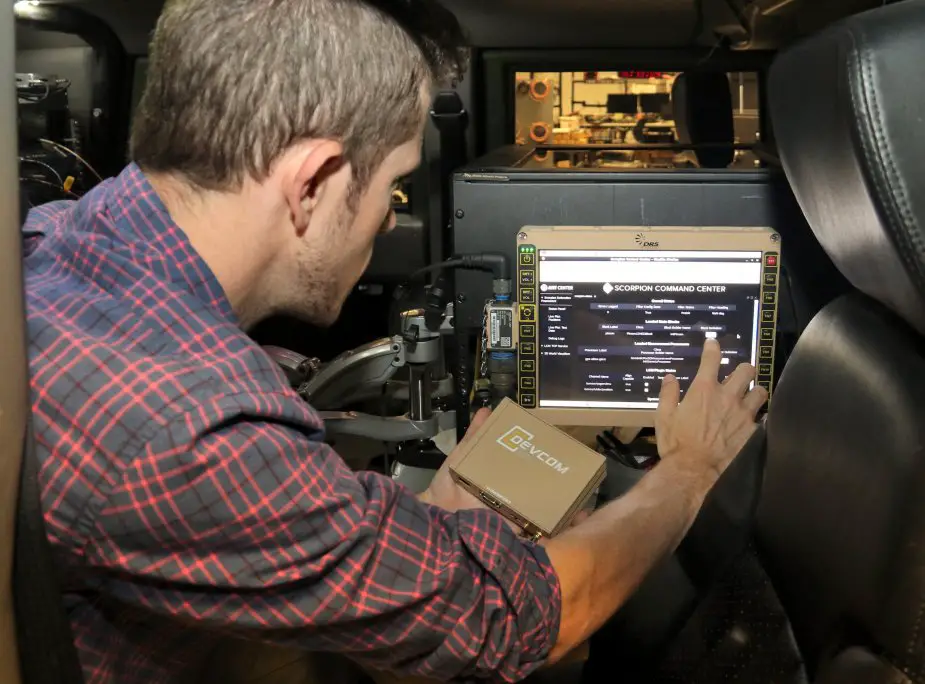Army Futures Command is developing a modular plug-and-play framework that will enable the rapid insertion of emerging position, navigation and timing, or PNT, technologies into Army air, ground and Soldier platforms. Dan Lafontaine, CCDC C5ISR Center Public Affairs, explains.

C5ISR Center computer scientist Zach Kjellberg conducts testing on a position, navigation and testing system at Aberdeen Proving Ground, Md., on June 13, 2019 (Picture source: Dan Lafontaine, CCDC C5ISR Center PAO)
The Modular GPS Independent Sensors project, known as MoGIS, is a shift from developing stand-alone PNT systems that have proprietary software and hardware interfaces. Instead, newly developed components can be integrated into a modular framework with a vendor-agnostic, multi-source solution. The modular open systems approach, or MOSA, uses accessible, published standards that are open for government and industry to work toward.
The Army's emphasis on open standards aligns with guidance from the Department of Defense, which in January announced prioritization in developing and implementing MOSA to ensure future weapons systems can communicate quickly. "We determined the continued implementation of these standards, and further development of Modular Open Systems Approach standards in areas where we lack them is vital to our success. As such, MOSA supporting standards should be included in all requirements, programming and development activities for future weapon system modifications and new start development programs to the maximum extent possible," noted the secretaries of the Army, Navy and Air Force in the memo.
MoGIS will reduce integration challenges and spur more industry opportunities as academia and small businesses are able to focus on their niche areas of expertise -- such as sensors and algorithms -- instead of being required to build an entirely proprietary system, said Michael Caporellie, the Navigation Sensors Team Lead with the Combat Capabilities Development Command, or CCDC, a major subordinate command within Army Futures.
"PNT directly affects all six of the Army's modernization priorities, so our goal is to improve this capability and expedite its transition and fielding. By developing this framework, we don't tie the hands of industry or government developers, so they're better able to innovate," said Caporellie, who is assigned to CCDC's Center for Command, Control, Communications, Computers, Cyber, Intelligence, Surveillance and Reconnaissance, or C5ISR.
"As long as you adhere to the framework and standards, everything should be modular, including updates, which can be folded into the overall system. Furthermore, it allows us to place new PNT technologies into the Army's standard architecture for testing, validation, demonstration and certification," he said.
To ensure future PNT systems have the capacity to rapidly change and maintain an operational advantage, the Assured Positioning, Navigation and Timing Cross-Functional Team, or APNT CFT, included an open systems architecture capability as part of the criteria for its recently approved directed requirement for the Mounted APNT solution.
"Today, we send our ground and aviation platforms back to the depot to be retrofitted for new PNT technologies and systems," said Willie Nelson, APNT CFT director. "Changes to the platforms then result in additional training for our Soldiers. This can be incredibly time consuming and expensive.
"With an open systems architecture in place, we can simply change out a card, or potentially send a patch to the Mounted APNT system, saving the Army money and time, while keeping our Soldiers focused on their mission. Army aviation and ground platforms both benefit from having such a standard, allowing us to potentially utilize similar, if not the same, PNT technologies in both the air and ground domains," Nelson said.
The center's Command, Power and Integration Directorate, or CP&ID, is leading the MoGIS project, which is being developed in coordination with the Army's C5ISR/Electronic Warfare Modular Open Suite of Standards, or CMOSS, program.
CMOSS, which was also developed by the C5ISR Center, lays the foundation for enhanced interoperability and simultaneity among C5ISR capabilities by fielding warfighting capabilities -- such as PNT, electronic warfare and mission command -- as cards in a common chassis instead of the traditional multitude of stove-piped "boxes."
"With MoGIS, the Army will be able to acquire and integrate cutting-edge PNT capabilities as they become available, thus allowing the platform community to keep pace with innovation and provide capability overmatch against emerging threats. In short, it will ensure that our forces are agile in every sense of the word," Caporellie said.
---------------------------------------------------------------------------------------------
The CCDC C5ISR Center is the Army's applied research and advanced technology development center for C5ISR capabilities. As the Army's primary integrator of C5ISR technologies and systems, the center develops and matures capabilities that support all six Army modernization priorities, enabling information dominance and tactical overmatch for the joint warfighter.
The C5ISR Center is an element of the U.S. Army Capabilities Development Command. Through collaboration across the command's core technical competencies, CCDC leads in the discovery, development and delivery of the technology-based capabilities required to make Soldiers more lethal to win our nation's wars and come home safely. CCDC is a major subordinate command of the U.S. Army Futures Command.















